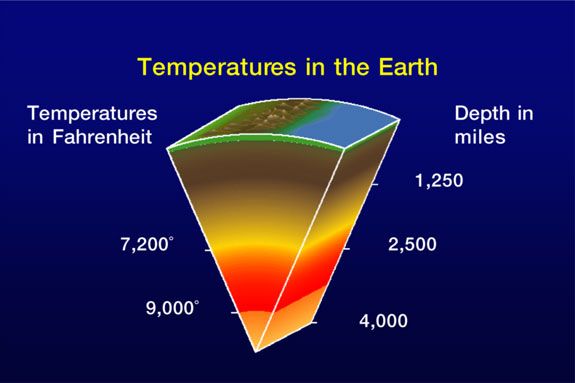The Pros and Cons of using Geothermal Energy
Geothermal energy is thermally generated and stored in the Earth. The geothermal energy of the Earth's crust originates from the original formation of the planet and from radioactive decay of the geothermal gradient, which is the difference in temperature between the core of the planet and its surface, drives a continuous conduction of thermal energy in the form of heat from the core to the surface. The adjective geothermal originates from the Greek roots γη (ge), meaning earth, and θερμος (thermos), meaning hot.

Temperatures at the core-mantle boundary may reach over 4000 °C (7,200 °F).] The high temperature and pressure in Earth's interior cause some rock to melt and solid mantle to behave plastically, resulting in portions of mantle convecting upward since it is lighter than the surrounding rock. Rock and water is heated in the crust, sometimes up to 370 °C (700 °F).
Geothermal energy has been used for bathing in hot springs since Paleolithic times and for space heating since ancient Roman times, but it is now better known for electricity generation. Worldwide, 11,700 megawatts (MW) of geothermal power was online in 2013.


Geothermal power is cost effective, reliable, sustainable, and environmentally friendly, but has historically been limited to areas near tectonic plate boundaries. Recent technological advances have dramatically expanded the range and size of viable resources, especially for applications such as home heating, opening a potential for widespread exploitation. Geothermal wells release greenhouse gases trapped deep within the earth, but these emissions are much lower per energy unit than those of fossil fuels. As a result, geothermal power has the potential to help mitigate global warming if widely deployed in place of fossil fuels.


The International Geothermal Association (IGA) has reported that 10,715 megawatts (MW) of geothermal power in 24 countries is online, which was expected to generate 67,246 GWh of electricity in 2010. This represents a 20% increase in online capacity since 2005. The IGA projects growth to 18,500 MW by 2015, due to the projects presently under consideration, often in areas previously assumed to have little exploitable resources.

In the 20th century, demand for electricity led to the consideration of geothermal power Lord Kelvin invented the heat pump in 1852, and Heinrich Zoelly had patented the idea of using it to draw heat from the ground in 1912. But it was not until the late 1940s that the geothermal heat pump was successfully implemented. The earliest one was probably Robert C. Webber's home-made 2.2 kW direct-exchange system, but sources disagree as to the exact timeline of his invention. J. Donald Kroeker designed the first commercial geothermal heat pump to heat the Commonwealth Building (Portland, Oregon) and demonstrated it in 1946.

The technology became popular in Sweden as a result of the 1973 Oil Crisis, and has been growing slowly in worldwide acceptance since then. The 1979 development of polybutylene pipe greatly augmented the heat pump’s economic viability. Geothermal electric plants were traditionally built exclusively on the edges of tectonic plates where high temperature geothermal resources are available near the surface. The development of binary cycle power plants and improvements in drilling and extraction technology enable enhanced geothermal systems over a much greater geographical range

The thermal energy of geothermal electric plants is low, around 10–23%, because geothermal fluids do not reach the high temperatures of steam from boilers. The laws of thermodynamics limits the efficiency of heat engines in extracting useful energy. Exhaust heat is wasted, unless it can be used directly and locally, for example in greenhouses, timber mills, and district heating.

Geothermal energy comes in either vapor-dominated or liquid-dominated forms. Geysers are vapor-dominated. Vapor-dominated sites offer temperatures from 240 to 300 °C that produce superheated steam.

Heating is cost-effective at many more sites than electricity generation. At natural hot springs or geysers, water can be piped directly into radiators. In hot, dry ground, earth tubes or downhole heat exchangers can collect the heat. However, even in areas where the ground is colder than room temperature, heat can often be extracted with a geothermal heat pump more cost-effectively and cleanly than by conventional furnaces. These devices draw on much shallower and colder resources than traditional geothermal techniques. They frequently combine functions, including air conditioning, seasonal thermal energy storage, solar energy collection, and electric heating. Heat pumps can be used for space heating essentially anywhere.

Iceland is the world leader in direct applications. Some 92.5% of its homes are heated with geothermal energy, saving Iceland over $100 million annually in avoided oil imports. Reykjavik, Iceland has the world's biggest district heating system. Once known as the most polluted city in the world, it is now one of the cleanest.
Geothermal power requires no fuel (except for pumps), and is therefore immune to fuel cost fluctuations. However, capital costs are significant. Drilling accounts for over half the costs, and exploration of deep resources entails significant risks. A typical well doublet (extraction and injection wells) in Nevada can support 4.5 megawatts (MW) and costs about $10 million to drill, with a 20% failure rate.


Geothermal power is considered to be renewable because any projected heat extraction is small compared to the Earth's heat content. The Earth has an internal heat content of 1031 joules (3·1015 TW·hr), approximately 100 billion times current (2010) worldwide annual energy consumption.[
Geothermal power is also considered to be sustainable thanks to its power to sustain the Earth’s intricate ecosystems. By using geothermal sources of energy present generations of humans will not endanger the capability of future generations to use their own resources to the same amount that those energy sources are presently used.. Further, due to its low emissions geothermal energy is considered to have excellent potential for mitigation of global warming.
Geothermal Energy is a cost efficient, renewable, clean source of energy that can help solve the global warming crisis.
Call Claire - 082 399 0180
bluedesigns5@gmail.com
Follow me on LinkedIn - https://www.linkedin.com/in/claire-cardwell-ab438a17
Follow me on Facebook - https://www.facebook.com/bluedesignsarchitects/
Follow me on Medium - https://medium.com/@clairecardwell